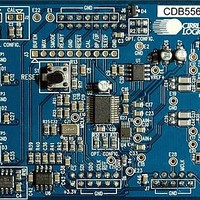CDB5566 Cirrus Logic Inc, CDB5566 Datasheet - Page 24

CDB5566
Manufacturer Part Number
CDB5566
Description
Dev Bd For I/C 24-bit, Diff, 5kSPS, DAQ
Manufacturer
Cirrus Logic Inc
Type
A/Dr
Specifications of CDB5566
Number Of Adc's
1
Number Of Bits
24
Sampling Rate (per Second)
5k
Data Interface
SPI™
Inputs Per Adc
2 Differential
Input Range
0 ~ 4.096 V
Power (typ) @ Conditions
20mW @ 5kSPS
Voltage Supply Source
Analog and Digital, Dual ±
Operating Temperature
-40°C ~ 85°C
Utilized Ic / Part
CS5566
Conversion Rate
5 KSPS
Resolution
24 bit
Maximum Clock Frequency
8 MHz
Interface Type
SPI
Supply Voltage (max)
3.3 V
Supply Voltage (min)
- 2.5 V
Product
Data Conversion Development Tools
Lead Free Status / RoHS Status
Contains lead / RoHS non-compliant
For Use With/related Products
CS5566
Lead Free Status / RoHS Status
Contains lead / RoHS non-compliant
Other names
598-1557
CDB-5566
CDB-5566
3/25/08
CS5566
3.11 Serial Port
The serial port on the CS5566 can operate in two different modes: synchronous self clock (SSC) mode &
synchronous external clock (SEC) mode. The serial port must be placed into the SEC mode if the offset
and gain registers of the converter are to be read or written. The converter must be idle when reading or
writing to the on-chip registers.
3.11.1 SSC Mode
If the SMODE pin is high (SMODE = VL), the serial port operates in the SSC (Synchronous Self Clock)
mode. In the SSC mode the port shifts out conversion data words with SCLK as an output. SCLK is gen-
erated inside the converter from MCLK. Data is output from the SDO (Serial Data Output) pin. If CS is
high, the SDO and SCLK pins will stay in a high-impedance state. If CS is low when RDY falls, the con-
version data word will be output from SDO MSB first. Data is output on the rising edge of SCLK and should
be latched into the external logic on the subsequent rising edge of SCLK. When all bits of the conversion
word are output from the port the RDY signal will return to high.
3.11.2 SEC Mode
If the SMODE pin is low (SMODE = VLR), the serial port operates in the SEC (Synchronous External
Clock mode). In this mode, the user usually monitors RDY. When RDY falls at the end of a conversion,
the conversion data word is placed into the output data register in the serial port. CS is then activated low
to enable data output. Note that CS can be held low continuously if it is not necessary to have the SDO
output operate in the high impedance state. When CS is taken low (after RDY falls) the conversion data
word is then shifted out of the SDO pin by driving the SCLK pin from system logic external to the converter.
Data bits are advanced on rising edges of SCLK and latched by the subsequent rising edge of SCLK.
If CS is held low continuously, the RDY signal will fall at the end of a conversion and the conversion data
will be placed into the serial port. If the user starts a read, the user will maintain control over the serial port
until the port is empty. However, if SCLK is not toggled, the converter will overwrite the conversion data
at the completion of the next conversion. If CS is held low and no read is performed, RDY will rise just
prior to the end of the next conversion and then fall to signal that new data has been written into the serial
port.
24
DS806PP1



















